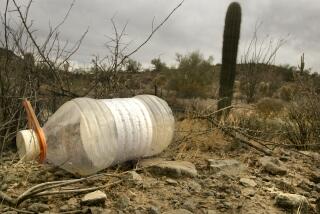Nevadans Get Into Dust-Up Over Emigrant Trail Route
- Share via
RENO, Nev. — Which way did they go?
One hundred and fifty years after the covered-wagon pioneers rolled through Nevada, history buffs are locked in an unprecedented legal battle over the location of the emigrants’ trail near Reno.
The pioneer trails group Trails West touched off the dispute in June when it announced plans to change three trail markers it said were placed inaccurately in Reno in the 1970s by another group.
Now the case has taken a twist with a group of local trail buffs accusing Trails West of incorrectly marking the trail leading into Reno. The locals blame Trails West members from California for the clash.
“It gripes the hell out of everybody here what they’ve done,” said Harold Curran, the 90-year-old Reno author of a book on the California Trail across Nevada. “They’ve come in and taken a part of our history away, saying locals don’t know what they’re talking about.”
Curran and other locals defend the work of the Nevada Emigrant Trail Marking Committee. It was headed by the late Walt Mulcahy of Sparks and was made up exclusively of Nevadans before it disbanded.
Last month, six local residents filed a lawsuit against Trails West and obtained a temporary restraining order forbidding it from uprooting or defacing any markers placed by Mulcahy’s group.
They contend that Trails West ignored conflicting evidence in proposing changes to three south Reno markers.
However, Trails West officials say emigrant diaries clearly show that the California-bound pioneers took a slightly more northerly, direct path through Reno.
A hearing on the lawsuit is set Nov. 8 before Washoe District Judge Jim Hardesty.
“I’m absolutely positive nothing like this has ever happened,” said Gregory Franzwa of Tucson, Ariz., founder of the Oregon-California Trails Assn. “The basic problem is some people don’t want to admit they’re wrong.”
Trails West historian Don Buck of Sunnyvale, Calif., said his group merely sought to bring the Reno markers in line with new research about where the trail went in the 1840s and 1850s.
The trail, the first wagon route over the Sierra Nevada, was crossed by the Donner party in 1846 and by up to a third of all the ‘49ers seeking their fortune. Hardly any trail traces remain in the Reno area.
Trails West’s research was conducted by a Reno resident, Don Wiggins, a retired Silicon Valley electrical engineer who has studied pioneer trails for 20 years.
At issue is whether Trails West can remove or alter the markers placed by Mulcahy’s group. Opponents say the group was only supposed to maintain the markers.
“They’re interested in protecting the legacy of Walt Mulcahy and his group,” Buck said. “We’re interested in protecting the legacy of the trail.”
However, Curran and other locals question Trails West’s accuracy, claiming that it’s wrong about the trail leading into Reno.
They maintain that the discovery of wagon ruts atop a small hill in Truckee River Canyon one mile east of the local sewer plant shows that the emigrants traveled all the way up the canyon into Reno.
Trails West has marked three separate trails leading into Reno. Two routes left the canyon and made brief traverses of the Virginia Range just to the south before 1852, Wiggins claims.
Only later wagon trains stayed in the canyon the entire way after a physical obstacle was removed, he adds.
“We don’t know what the obstacle in the canyon was, but it was cleared by 1852,” Wiggins said.
Retired high school history teacher Fred Horlacher of Reno insists that all emigrants were able to stay in the canyon by crossing the small hill just before entering the Reno valley.
Emigrant diaries describe going up such a hill, but not a nearby steep, indirect mountain route now marked as the 1849 trail by Trails West, he contends.
“Why would they leave the river and go up that incredibly difficult mountain when they’re only a half mile from the end of the canyon?” Horlacher asked.
But Wiggins said he thinks that the mountain route leading out of the canyon matches the diaries better. That route involves a one-mile, 800-foot ascent; the hill, a tenth-mile, 100-foot climb.
“I knew about the hill some time ago, and I ruled it out because it’s much too small,” he said. “The diarists describe crossing something much steeper and tougher, and the hill doesn’t fit.”
Two University of Nevada, Reno professors also are split.
“The emigrants would have to be smoking locoweed to go up [the mountain],” said Paul Starrs, a geography professor. “These are people who took the path of least resistance. The hill makes perfect sense.”
History professor Bill Rowley disagrees.
“What we might think is impossible was possible to them,” he said. “Back then, I really think the Truckee River was much higher and marshes along it extended higher, and that’s what blocked the way up the canyon for the emigrants.”
But Ken Adams, a geomorphologist with Reno-based Desert Research Institute, said old photographs show that the Truckee in that stretch has changed little since the 1860s.
“I think there would have been a way through the canyon, and I doubt the emigrants went up the mountain,” he said.
Buck said he’ll ask Trails West to reconsider the issue, but it could take up to a year to resolve.
More to Read
Sign up for Essential California
The most important California stories and recommendations in your inbox every morning.
You may occasionally receive promotional content from the Los Angeles Times.










